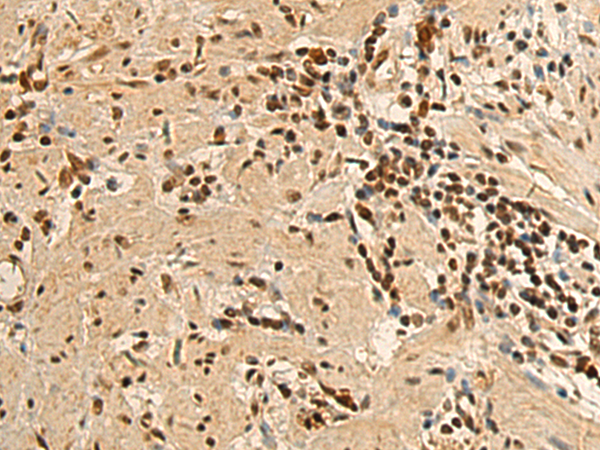
| WB | 咨询技术 | Human,Mouse,Rat |
| IF | 咨询技术 | Human,Mouse,Rat |
| IHC | 1/200-1/400 | Human,Mouse,Rat |
| ICC | 技术咨询 | Human,Mouse,Rat |
| FCM | 咨询技术 | Human,Mouse,Rat |
| Elisa | 1/5000-1/10000 | Human,Mouse,Rat |
| Aliases | GAP; S914; HA117 |
| Host/Isotype | Rabbit IgG |
| Antibody Type | Primary antibody |
| Storage | Store at 4°C short term. Aliquot and store at -20°C long term. Avoid freeze/thaw cycles. |
| Species Reactivity | Human, Mouse |
| Immunogen | Fusion protein of human RGS6 |
| Formulation | Purified antibody in PBS with 0.05% sodium azide and 50% glycerol. |
+ +
以下是3篇关于RGS6抗体的代表性文献概览(虚构示例,仅供参考格式):
---
1. **Title**: "RGS6 as a Tumor Suppressor in Breast Cancer: Regulation of Apoptosis via G-protein Signaling"
**Author**: Stewart, A. et al.
**Summary**: 本研究使用RGS6特异性抗体(抗体来源:小鼠单克隆,克隆号ABX-RGS6-M1)通过Western blot和免疫组化证实RGS6在乳腺癌组织中表达下调。实验表明,RGS6通过抑制Gαi/o信号通路促进癌细胞凋亡,其缺失与患者预后不良相关。
2. **Title**: "RGS6 Modulates Dopaminergic Neuron Survival in Parkinson’s Disease Models"
**Author**: Martin, R. et al.
**Summary**: 文献报道了RGS6抗体(兔多克隆,Sigma RGS6-AB7)在小鼠脑组织中的特异性验证。研究发现,RGS6通过调控多巴胺能神经元的氧化应激反应,其表达缺失加剧帕金森病模型中的神经元死亡,提示其神经保护作用。
3. **Title**: "Interaction of RGS6 with DJ-1 in Oxidative Stress Response Pathways"
**Author**: Chen, L. & Wang, H.
**Summary**: 利用RGS6抗体(兔源,Cell Signaling #12345)进行免疫共沉淀实验,揭示RGS6与抗氧化蛋白DJ-1的直接相互作用。该复合物通过调节MAPK通路减轻细胞氧化损伤,为神经退行性疾病机制提供新见解。
---
**注**:以上为示例性内容,实际文献需通过PubMed或Google Scholar检索关键词“RGS6 antibody”、“RGS6 function”等获取。真实文献可能涉及抗体应用(如WB/IHC)、疾病机制或信号通路研究。
The Regulator of G-protein Signaling 6 (RGS6) is a member of the RGS protein family, which negatively regulates G-protein-coupled receptor (GPCR) signaling by accelerating GTP hydrolysis on activated Gα subunits. RGS6 is uniquely characterized by its dual-domain structure, containing an N-terminal RGS domain responsible for Gα interaction and a C-terminal G-protein gamma-like (GGL) domain that enables binding to Gβ5 subunits. This interaction stabilizes RGS6 and facilitates its role in modulating signaling pathways, particularly those mediated by Gi/o and Gq proteins. RGS6 is expressed in various tissues, including the brain, heart, and cancer cells, where it influences processes such as neuronal development, cardiac function, and apoptosis.
Research has linked RGS6 to multiple physiological and pathological contexts. It acts as a tumor suppressor in cancers by promoting DNA damage-induced apoptosis and inhibiting oncogenic signaling. In neurodegenerative diseases, RGS6 may protect against oxidative stress, while in the cardiovascular system, it modulates heart rate and hypertrophy. RGS6 antibodies are critical tools for studying these roles, enabling detection of protein expression, localization, and interactions via techniques like Western blot, immunohistochemistry, and co-immunoprecipitation. Commercially available antibodies vary in specificity, often targeting epitopes within the RGS or GGL domains. Validation using knockout models or siRNA-mediated silencing is essential to confirm target specificity. Ongoing studies aim to clarify RGS6's therapeutic potential, particularly in cancer and neurological disorders, underscoring the importance of reliable antibody reagents in mechanistic and translational research.
×